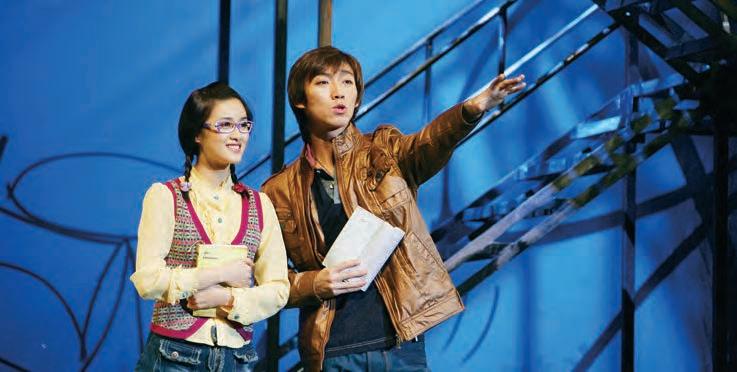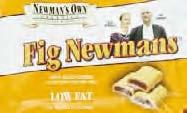
















ThisisthefirstofaseriesofView interviews with principals of public school located in the neighborhood A different school will be featured throughoutthewinterandspring.
The 2013-2014 school year marks Wendy Cheong’s first year as Starr King Elementary School’s principal. Before coming to Starr King, Cheong was an assistant principal at Gordan J. Lau School, and worked at the San Francisco Unified School District’s centralofficeastheMandarinimmersioncurriculumcoordinator.Shestartedhercareerasaclassroomteacherat JeffersonElementarySchool.
View : What should the community knowaboutStarrKing?
Cheong: We are a very diverse school, with balanced representation of all cultural groups and ethnicities, includingAsians,African-Americans, Latinos,andCaucasians.Wehavefour differentprogramsattheschool.These arepre-k,Mandarinimmersion,special dayclass,andgeneraleducation,meaningEnglishonly.Mandarinimmersion is the larger program, with 200 to 220 students right now. It begins with 80 percent instruction in Mandarin in kindergarten and first grade, and slowly increases until it is about halfhalf English-Mandarin by the fourth and fifth grades. Special day class is forourstudentswhohavemoderateto severe autism and require specialized instruction from both teachers and paraprofessionals.
View: How many Starr King students
liveinDogpatchorPotreroHill?
Cheong: While we are a citywide school, roughly one-third of our kids come from the neighborhood. Generally speaking, neighborhood kids are in the general education or Mandarin program.However,theMandarinprogram draws children who come from allovertheCity.
View:Whataresomerecentorongoing initiativesatStarrKing?
Cheong: Wehavemanyprogramsat oneschool,sowearealwaysworkingon creatingaunitedcultureasoneschool. We want a culture of peace builders, and we encourage the use of words to resolveconflict.Wedevelopsocialskills andworkontheacademiccurriculum. Itshouldn’tmatterwhatprogramstudents are in or where they come from; we want all students and parents to

have the same access to activities and programs.Thatisourmission.
View:Arethereanyphysicalimprovementsonthehorizon?
Cheong:Wewillberenovatingour school and implementing a new green schoolyard initiative. The greening will help build up our environmental educationprogram,eco-literacyifyou will. Currently, we have a gardening program where the gardening coordinator and teachers work hand-in -hand to provide experiences that coordinates with their science units. Our new green yard will transition the children from play in a more traditional sport environment to a more nature setting. Reconstruction will begininMarch.Bungalows,servingas temporary classrooms, will move into theschoolyard.Thecompletiondateof the whole project is October 2015. The construction will be in phases, and we are trying to make sure there are minimaldisruptions.
View: How can community members volunteer or get involved with the school?
Cheong : We welcome volunteers.
STARRKINGpage25




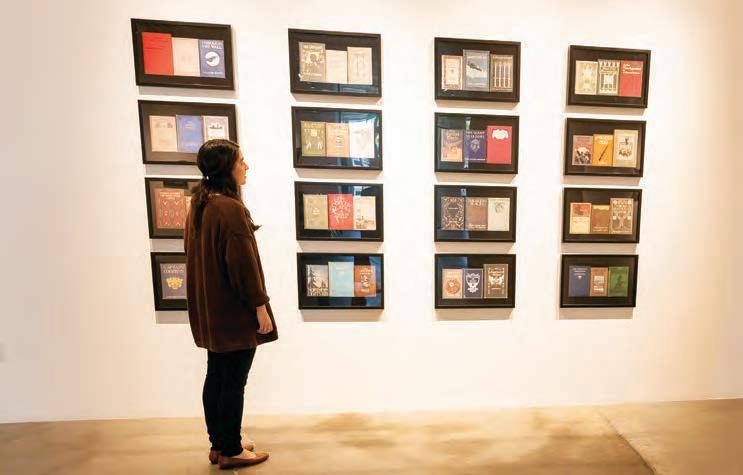
Over the past year a community of art galleries has emerged on 16th Street, Utah Street, and Potrero Avenue, with roughly a half-dozen exhibitspacesnowonoffer.Thecluster hasreplacedValenciaand16thstreets as a key artist hub, as galleries and shops in that area steadily close or move. Recent arrivals to Potrero Hill include the George Lawson Gallery , Jack Fisher Gallery , Catherine Clark Gallery, Brian Gross Fine Art, and Hosfelt Gallery. And the California College for the Arts’ Wattis Institute for Contemporary Arts and Artitud arewithinwalkingdistance.
“The Potrero neighborhood and adjacent Dogpatch and Mission are desirableareasofSanFrancisco,with
a healthy blend of cultural venues, educationalinstitutions,residents,designbusinesses,andnonprofits.Itwas therefore a compelling neighborhood for us to consider for the re-location of the gallery,” said Catharine Clark, of her gallery. “The addition of new and more galleries deepens the many reasons people already are drawn to the area, and expands our audience to include patrons who may have avoideddowntowninrecentyearsdue tocongestion,traffic,lackofparking, andnoise.”
“InitiallyIpickedPotrerobecause this is where I found a building that would work; a space that had the right volume, light, accessibility, and affordability to support the gallery’s program,” said Lawson. “After my experience in Los Angeles with a
storefront—whichisthenormthere—I wantedgroundflooraccessratherthan anupstairsspace,asIhadat49Geary. Nowthatweareinstalledhere,Ifind thelocation,easeofparking,ambience and, of course, the proximity to my colleagues and other art resources to be invaluable. The location is equally convenient for Peninsula, East Bay and City audiences. Foot traffic has beensteady—there’sacrowdhereright now—and business has been good. We’ve received a lot of attention and the reception has been very positive. Intermsofthepotential,Ithinkother gallerieswillsurelyfollowsuit.”
“Iamencouragedbythewelcome we have experienced from the neighbors in Potrero, and by the new faces inthegallery,”saidClark,whomoved hergalleryfromMinnaStreet.
“We’ve had a great reception. It
has been great to have visitors and to dobusinesswithclientsweneversaw at49Gearyaswellasourestablished clientele.Therehasclearlybeenaneed forSanFrancisco’sartscenetoexpand intoanewareaoutsideofdowntown,” saidBrianGross.“I’mthrilledtohave relocatedtoPotrero.”
“We have become a much needed newarthub,”saidJackFisher.
“The Potrero location has not changedthefocusoftheartweshow,” added Lawson. “Our commitment to contemporary painting on an international scope is only strengthened by the ease and economy with which we can mount exhibitions in the new space. San Francisco’s art galleries are an amazing resource for the City. We are free, remarkably varied in our offerings, and now that five of us plus the Wattis are within walking distanceofoneparkingspace,readily accessible. I hope a new crop of folks will rediscover the simple pleasure of galleryhopping.”
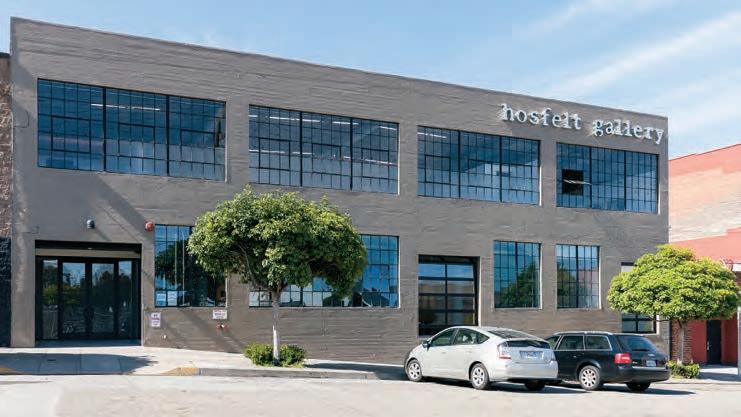

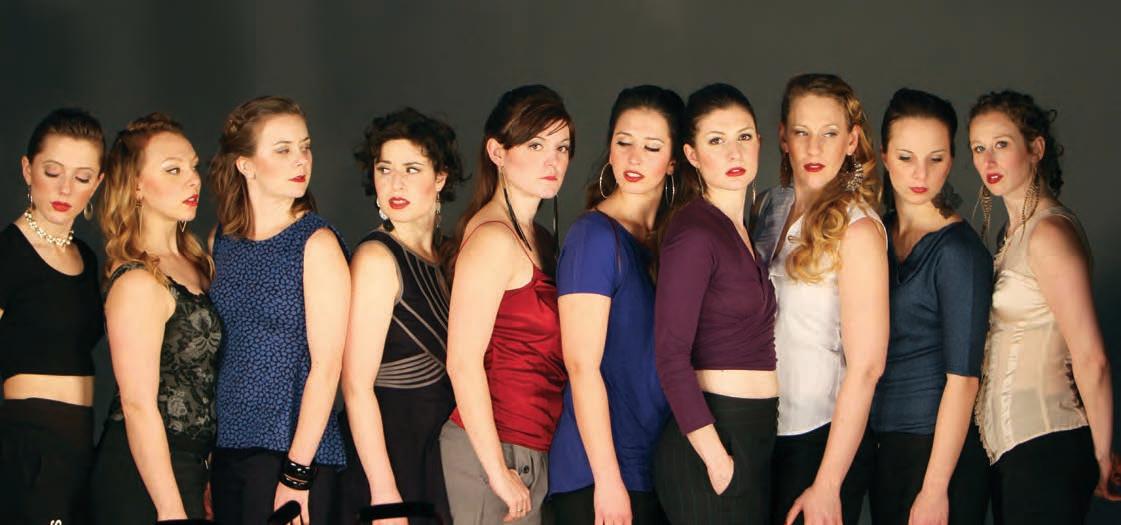
The word “powerful” doesn’t do justice to Bianca Cabrera’s new production, The Aftermath Affair , at ODC Theatre. With an all-female company of 16 dancers, known as the Blind Tiger Society, an original soundtrack composed by Ben Juodvalkis, Aftermath is an astounding tour de force and brilliant calling card for Cabera and Juodvlkis, two rising stars of the Bay Area dance world.
The result of years of collaboration, Aftermath is a visceral, theatrical work that bristles and aches with intensity, virtuosity, and sub -
limity. Imagine post-Burning Man, Nine Inch Nails-styled industrial tracks colliding with mesmerizing soundscapes; dancers with the delicacy, precision, and athleticism of Baryshnikovmeltingandexploding intoeachothers’bodieswithatomic energy.
Through an intense mixture of energy,movementandsound,theSocietygivesataut,supernovaperformance that will leave unsuspecting audiences breathless, emotionally drained but wanting more.
Both Cabrera’s and Juodvalkis’ geniusisobvious.ThoughAftermath boastsnoplot,itsimagisticapproach

tells a profound and timeless story of the human struggle to survive, balancing internal and external forces. Jodvalkis’ lush beats and sometimes elegiac score are the perfect complement to Cabrera’s propulsive, exhaustive creativity.
Cabreracallshercompany“Blind TigerSociety”inhomagetoherWest Oaklandbaseofoperation,wherethe Viewwitnessedarehearsalof Aftermath . The term was the nickname forProhibition-eraspeakeasiesand, according to Cabrera, pays tribute tothedo-it-yourselfethosoftoday’s dance artists.
Born in Los Angeles of Mexican and Polish descent, Cabrera traveled through Chicago, Colorado, and Seattle before landing in San Franciscotofoundherdancetroupe. The young choreographer juggles multiplejobs—teaching,bartending, and studio management—to bring her works to fruition. Funding to payfortheperformancespacecomes from the Fleishhacker and Rainin Opportunity Awards.
Ifyouonlyseeonecontemporary dance performance this year make it The Aftermath Affair . You won’t regret it...and you’ll never forget it.
The show runs February 28 to March 2, 8 p.m. at ODC Theatre. Tickets: pre-sale $20/at the door $25, Student/Senior $20. For information: 415.863.9834 or http://odcdance.org/performance. php?param=187.


Currently 1601 Mariposa is used as a parking lot, diesel bus depot and the Mackenzie auto parts warehouse. Our plan for this mixed-use development is to transform much of this industrial area into a beautiful and accessible public open space and a fexible neighborhood gathering place where the community and residents can read, exercise, catch up with friends, organize children’s playdates and congregate for community events and activities.
One of the hallmark features of 1601 Mariposa is over 21,000 square feet that make up the Midblock Mews, the publicly accessible greenway leading to Jackson Playground which allows for convenient pedestrian access from 18th Street to Mariposa Street. The Mews is thoughtfully designed to encourage child’s play and community engagement such
as farmers markets or movie nights. We will be using sustainable landscaping, planting new trees and hearty plants, improving street drainage, and creating public seating areas and dynamic formations to transform this parking lot into an engaging outdoor space the whole community can enjoy.
Additionally there will also be two parklets on the corners of Mariposa & Carolina and 18th & Arkansas along with courtyards, gardens and terraces reserved for residents – all adding up to over 39,000 square feet of open space. This is nearly twice the required amount because we feel it creates a happier and healthier environment, refecting the true San Franciscan lifestyle. That’s defnitely something that will all make us breathe a little easier.




TheView isdelightedtopublishlocalkids’birthdays andmilestones.Pleaseemailyourimageand/orcaptiontoproduction@potreroview.netbythe18thof thepriormonth.Highresolutionphotos,please!
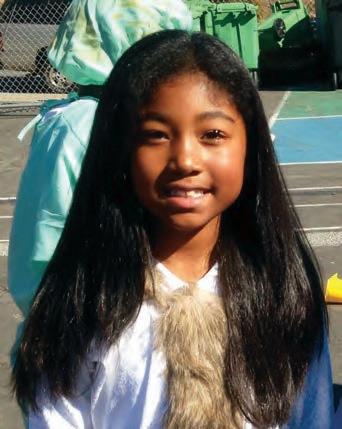






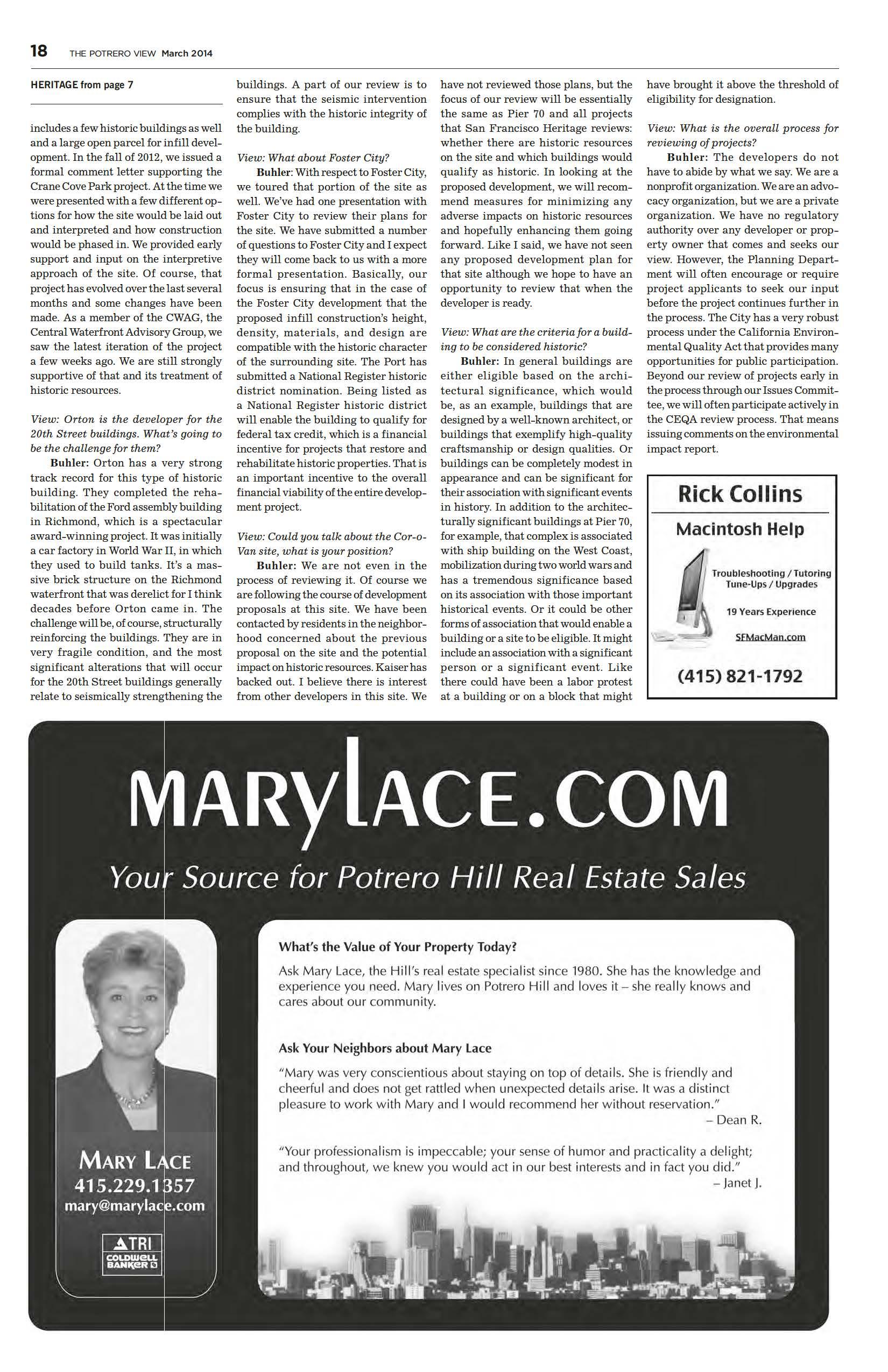
Potrero Hill has emerged as an important node in San Francisco’s vibrant art scene. As noted in “Potrero Emerges as Art Hub” in this issue, over the past year the Catherine Clark, Todd Hosfelt, and Brian Gross galleries have relocated to a renovated building at 260 Utah Street, and Jack Fisher and George Lawsonhaveopenednewgallerieson Potrero Avenue. In addition, the San Francisco Center for the Book—locatedonDeHaroStreetforseventeen years—recently moved to a newly designed,expandedspacearoundthe corner on Rhode Island Street.
Adding to the vitality of the arts on the Hill has been the relocation of the California College of the Arts’ Wattis Institute for Contemporary Arts, Kent and Vicki Logan Galleries, to 360 Kansas Street. This new gallery space, which was redesigned and completed in 2013, is walking distance from Eighth Street, where CCA built its San Francisco campus inthemid-1990s.TheWattisInstitute hosts exhibitions and discussions focusing on contemporary art, and provides training opportunities for CCAstudentsinvolvedinthecuratorial practice program.
The Wattis Institute’s new location has improved its potential to connect with the neighborhood’s lively street life. According to Rita Souther, Wattis Institute programs coordinator, in addition to students, working artists, and art professionals, a great number of the Institute’s visitors are people who walk in off the street. With its large street front windows that permit viewing of the gallery, the new Wattis naturally attracts attention during open hours. This encouraged local residents to explorethespaceduringitsfirstyear. Attendance has grown with awareness of the gallery’s exhibitions and
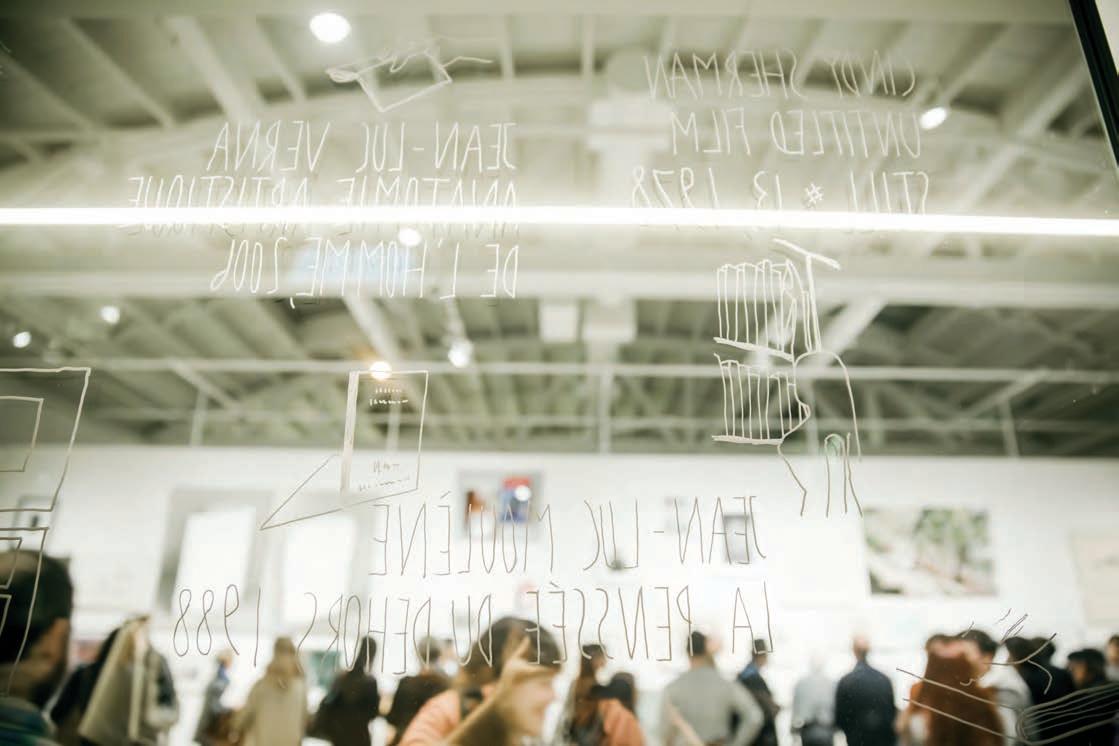
accompanyingprograms,allofwhich are free to the public.
The Institute’s current curatorial vision is a continuation of the programming that was planned for the gallery while it was still on the CCA campus, where it was created in 1998. This included establishing a relationship with the Mission District-based Kadist Art Foundation. In 2013, Kadist created a fellowship programforaCCAstudent,whowill work with the Kadist Foundation, Paris, to create programming that willtakeplaceattheWattisInstitute.
HeidiRabben,thecurrentKadist Curatorial Fellow, chose an artist from the Kadist collection for the current Wattis exhibition and pub -
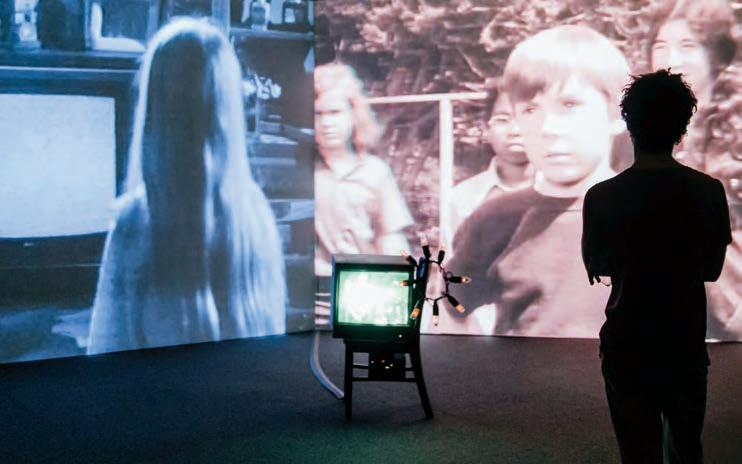

lication, titled Provisional Realities SheselectedDariaMartin,aLondonbased artist originally from San Francisco, who has been exploring the intensive relationship between objects, subjects, and reality in film. In considering how something—such as an object or film — becomes part of and is absorbed into a collection, Martinbecameinterestedinshowing her work with artist Susan Hiller, an American-born artist who is also
a longtime London resident. Like Martin, Hiller’s films address questions concerning reality, phenomena suchasautomaticwriting,andlevels ofconsciousness,andthebody,allof which work to shift viewers’ ideas about dreams, memory, and perception. Both artists’ works operate in conceptual and perceptual spaces between conscious, unconscious,
WATTISpage23
 Above Codex on during opening night. Right
ProvisionalRealities PHOTOGRAPHS BY NIKKI RITCHER, COURTESY OF CCA WATTIS INSTITUTE
Above Codex on during opening night. Right
ProvisionalRealities PHOTOGRAPHS BY NIKKI RITCHER, COURTESY OF CCA WATTIS INSTITUTE
“Comevisit,andcomevisitoften,” invitedMarcD’Estout,theMuseumof CraftandDesign’scurator.D’Estout,a wiry man sporting a salt-and-pepper Van Dyke beard, radiates passion for themuseum.The10-year-oldmuseum was located downtown for a number of years but had been temporarily homeless before moving to Dogpatch lastApril.D’Estoutenthusedthatthe neighborhoodis“richwithcreativeenergy.TheSanFranciscoArtInstitute’s GraduateCenterisupstairs,Workshop Residence is nearby on 22nd Street, and the neighborhood is changing.” He proudly pointed out the museum’s much larger space, with its flexible gallery configuration, high ceilings, andLEDspotlights.
D’Estout curated the current exhibition ObsessiveReductive ,which isonviewthroughMarch30 .Thisgroup exhibition showcases 18 local and nationalartists,includingDrewDaly, Brian Dettmer, and Jim Dingilian. “They take the process to different extremes, intricately, precisely, and “obsessively” removing material by handtocreateextraordinaryimagery in works that involve astonishingly complex patterns or form,” D’Estout explainedinhiscuratorialstatement.
“In many cases, the use of material absence is employed as a significant design component, positioning negative space as the dominant element in thework.”
A found chair, hand-sanded for more than 300 hours by Daly, seems to be disappearing before one’s eyes.
Many of the other artists spent as much time, or more, hand-crafting their work, meticulously removing material to create an unexpectedly visual experience. Although much of the work is paper-based, there are notableexceptions.FarnazShadravan, who also works as a dental assistant, removedtheporcelainfromfourfull-
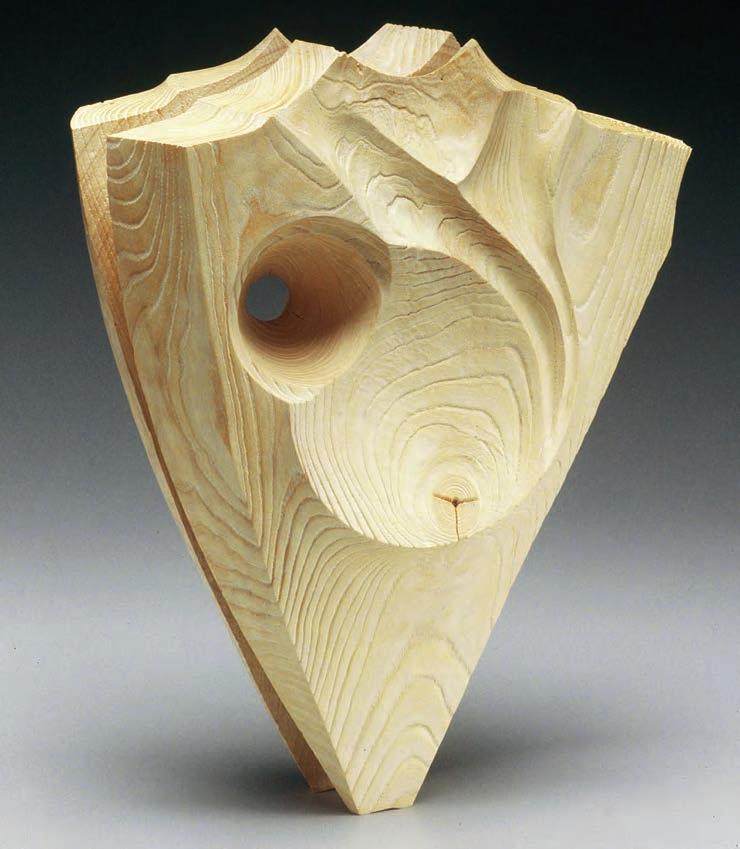
size bathtubs to create reproductions ofdrawingsbyAlbrechtDurer.Dingilian smoked the interiors of old glass bottles with candle soot, and through a process of delicate scraping depicts the marginal landscapes where such discardedbottlesmightbefound.Each of the two- and three-dimensional wall hangings and sculptural objects bear close scrutiny; the more closely one looks the more they reveal their mysteries as they begin to “converse” withoneanother.
In the museum’s larger gallery A Sense of Balance: The Sculpture of Stoney Lamar is on exhibit through March 23. The exhibition serves as a retrospective of the artist William

TheFriendsofJacksonPlaygroundwantstohearwhat improvementsyou’dliketoseemadeatourlocalpark. Followingthemostrecentspateofhypodermicneedles,crack vials,brokenbottlesandotherdetritusfoundinthesand,it’stime tocastacriticaleyeonJacksonPlaygroundtoensurethatit’s meetingthedemandsofourrapidlygrowingneighborhood. Pleasehelpustodevelopanactionplantopresenttothecityin thehopesofsecuringaCommunityOpportunityFundtomakeour wishlistsareality.WewillbeholdingtwopublicmeetingsinMarch tofurthersolicitideasandinputfromneighbors andparksupporters.
NOWISYOURCHANCETOMAKEYOURVOICEHEARD.JOINUS!
Saturday, March 1st: JacksonClubhouse,ArkansasSt.and17thStreet,1-2:30pm
Thursday, March 13
LiveOakSchool,1555MariposaSt,7-8:30pm. Wewillhavesnacksandrefreshmentsattheready.
WANTMOREINFORMATIONORWANTTOGETMOREINVOLVED?
CONTACTUS:FRIENDSOFJACKSONPARKSF@GMAIL.COM
LOOKFORUSHERE:HTTP://FOJP.TUMBLR.COM
StoneyLamar,basedinSaluda,North Carolina. Guest Curator Andrew GlasgowoftheAshevilleArtMuseum described Lamar’s process, “Crafted primarilythroughauniqueapproach to multi-axial lathe work, Lamar’s wood sculptures embody a distinct

senseoflineandmovement.Occasionally putting paint and metal to use in his works, Lamar frequently allows the shape, color, and modeling of the wood to determine a piece’s finished appearance.”Thoughstillquiteactive, Lamar’s work changed after he was diagnosed with Parkinson’s disease. The show includes some of his new and experimental pieces. Renowned local exhibit designer Ted Cohen is responsibleforbothinstallations.
D’Estout highlighted upcoming shows: The Tag Project by Wendy Maruyama, an installation referencing Executive Order 9066; as well as an exhibit showcasing the work of Tel Aviv designer Peddy Mergui. As might be expected, the museum’s well-stocked gift shop features items expertly chosen for their relationship to design and craft: toys, home décor, books,jewelry,accessories,andmore. It’saperfectcomplementtotheexperience,asarethefrequentprogramsfor bothadultsandchildren.AsD’Estout suggested, this museum merits visits, andrepeatvisits.
Museum of Craft & Design is at 2569 Third Street, between 22nd and 23rdstreets.http://www.sfmcd.org/.

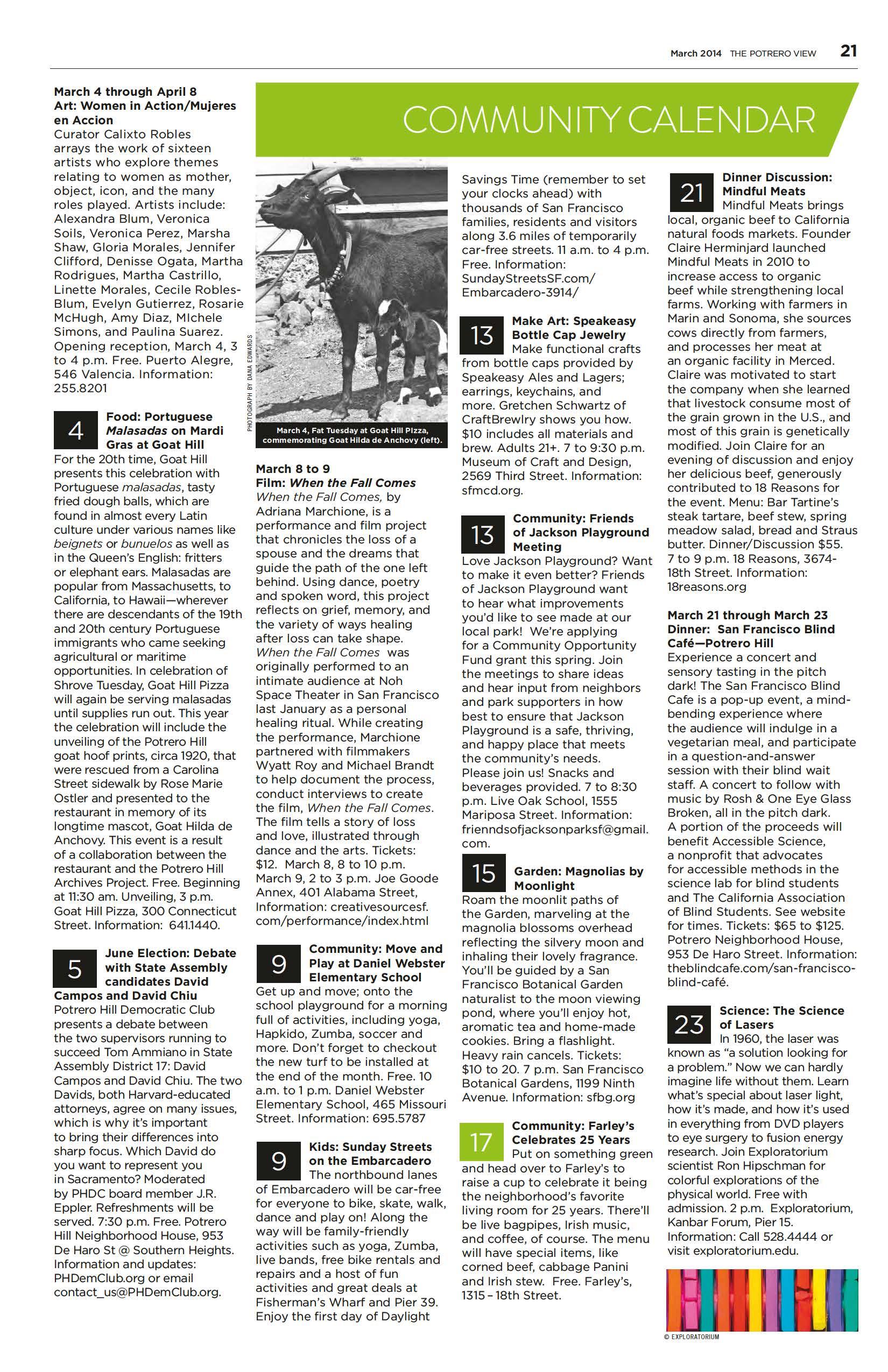

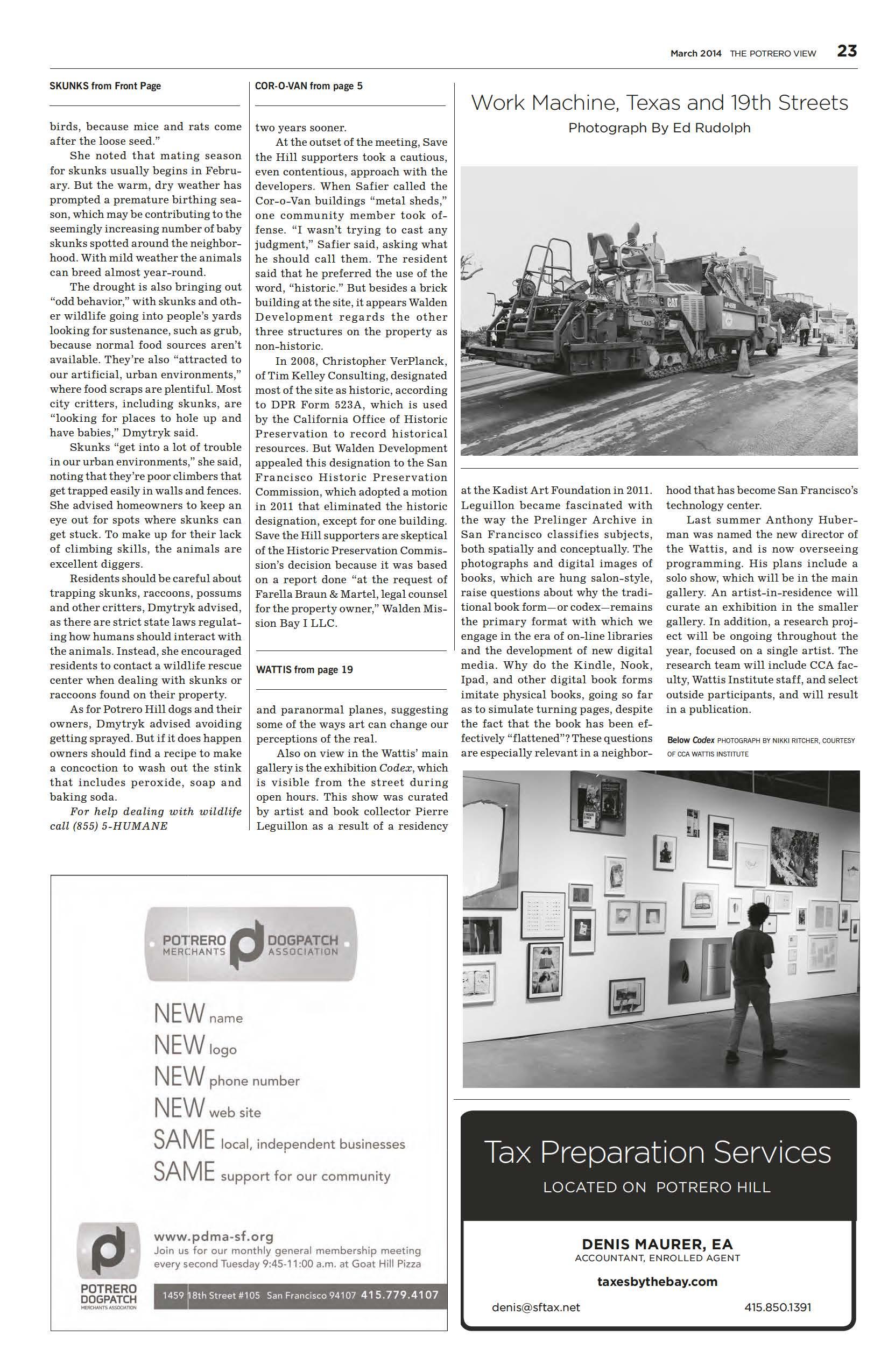

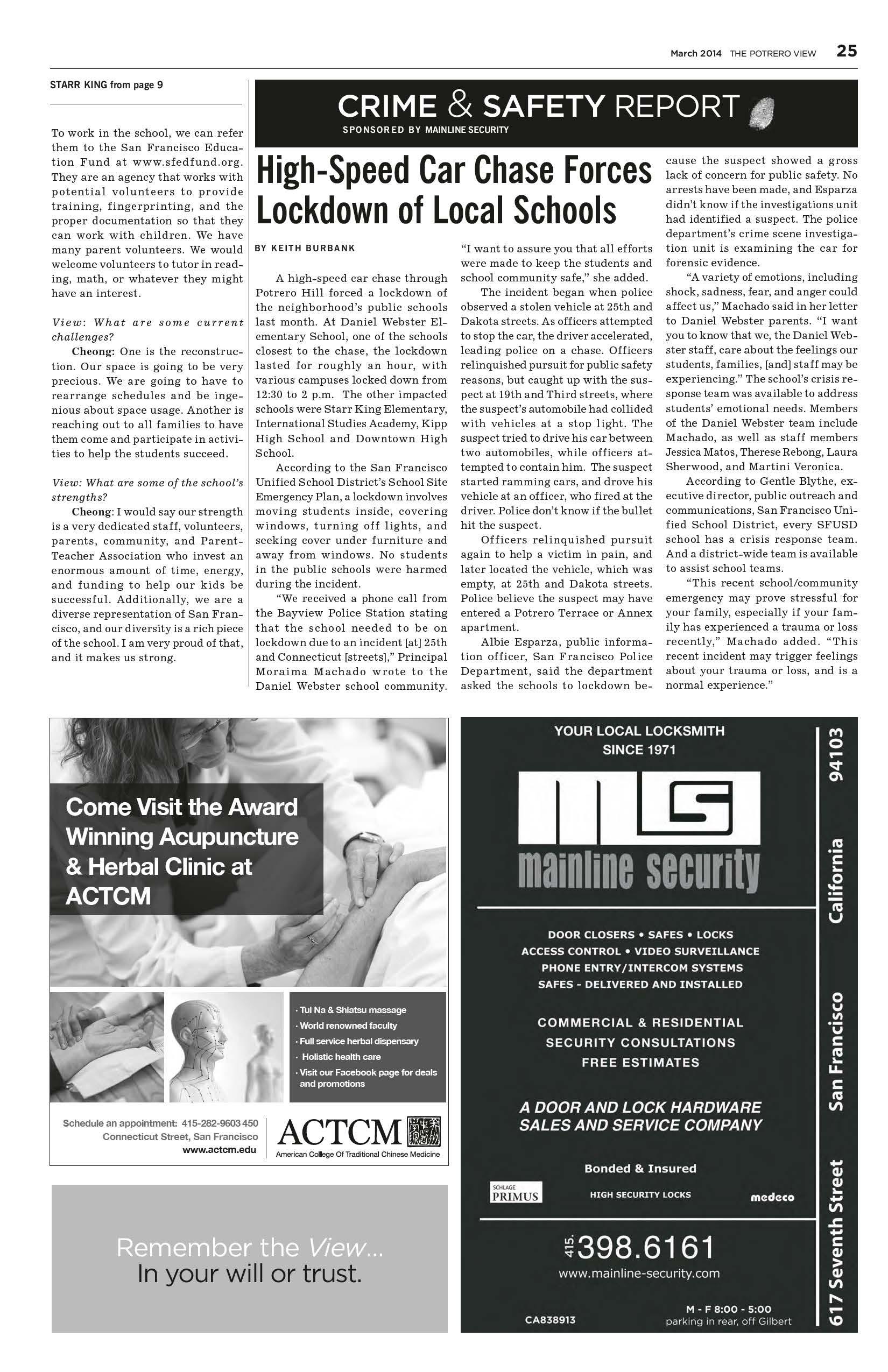

Hao Wu lived in Potrero Hill for only a few years, while commuting to Excite.com in Silicon Valley, but the experience made a lasting impression on him. He has fond memories of the neighborhood, where he still visits manyfriendsandformercolleagues.
With a degree in molecular biology from Brandeis University and a masters of business administration from the University of Michigan, Wu entered the technology industry. But his heart was always in storytelling. Wu’sfirstfilm,BeijingorBust ,documented the experiences of six diverse “ABC”s–American-bornChinese–who left their American jobs and families to make a home in Beijing. His latest documentary, The Road to Fame , chroniclesthestagingoftheAmerican musical Fame,China’sfirstofficialcollaborationwithBroadwaybythesenior class at Central Academy of Drama, China’smostprestigioustheaterschool.
Wu heard about the production from a friend, and was pleasantly surprisedtobeallowedunprecedented access to the proceedings; Chinese educationalinstitutionsareoftenvery protective of their students’ privacy. During the eight-month filming process in 2009, Wu followed students as theycompetedforroles,struggledwith pressure from family and authorities, and prepared to graduate into a cutthroatandcorruptshowbusiness.Part of China’s single-child generation, many of the students were spoiled
growing up but now feel obliged to carry on the failed dreams of their parents.Thefilmfocusesonfiveyoung adults who must confront complex socialrealitiesandtheirownanxieties, and, in the process of staging Fame , negotiate their own definitions of and pathstosuccessintoday’sChina.
While creating the documentary Wu also worked in Beijing, first for alibaba.com, and then for tripadvisor. com, filming during evenings and weekends.Lackingtimetoedit,heput the film on hold until he quit his day jobattheendof2011.
Nolongerinthetechnologyindustry, Wu now devotes himself fulltime to filmmaking, dividing his time betweenBeijingandNewYork,where his partner is in the finance industry. When the View spoke to him Wu was in Mexico participating in a fellowship program sponsored by the New America Foundation, “a nonprofit, nonpartisan public policy institute that invests in new thinkers and new ideastoaddressthenextgenerationof challengesfacingtheUnitedStates.”
Wu is dedicated to storytelling, specifically showing the complexities of contemporary China. He believes it’s important for Americans, and especiallyCalifornians,tohaveamore nuancedunderstandingoftheChinese people,otherthanthegood/badimages portrayedinmainstreammedia.
isbeingbroadcastonpublictelevision in England, the Netherlands, Denmark, and Israel. Wu is pursuing other international markets and film

festivals, and hopes that PBS will acquire the film. In the meantime, this entertaining and illuminating filmscreenstwiceatCAAMFest2014, onMarch15at4:30p.m.andMarch21 at9p.m.
The11-dayfestival,whichtakes place from March 13 to 23 at the Sundance Kabuki Cinema, and


is sponsored by Center for Asian American Media, “aims to explore the landscape of Asian and Asian Americansinallavenuesofmultimedia.Throughliveevents,freshmusicaltalent,culinaryartsandcinema, CAAMFestgivesfestivalattendeesa diverse, immersive experience that entertains and enlightens.”

